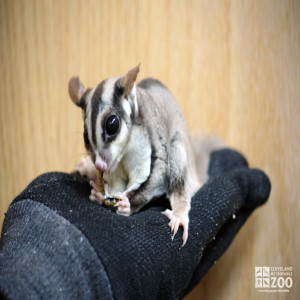Sugar Glider
[Petaurus breviceps]

In the sugar glider, the head & body length can vary from 5 to 12.5 inches; tail length from 6 to 8 inches, and weight from 3 to 5 ounces. The fur is fine and silky. A dark dorsal stripe runs from the nose to the rump, and there are stripes on each side of the face from the nose through the eye to the ear. A gliding membrane extends all the way from the outer side of the forefoot to the ankle, and is opened by spreading the limbs straight out. Females have a well-developed pouch during the breeding season. The number of mammae is usually 4, but occasionally 2. Sugar-gliders are shy and inconspicuous, having little reflective eyeshine and the ability to move quickly. They exhibit a complex social system, which varies somewhat according to the type habitat in which they live. The basic social unit consists of 2 to 7 adults (typically 5 to 7) – 2 or 3 adult males and 3 or 4 adult females. Group members share a tree hollow in which they build a spherical or bowl-shaped nest of eucalpyt leaves, but they generally forage alone at night. Group membership is closed to outsiders unless a vacancy is created by the death of a member. The dominant male in each group marks other group members with secretions from his head and chest scent glands. There are a variety of calls, including a loud bark or ‘yip’, and a rolling ‘starter motor’ anger call. Juveniles make a hiss when threatened, and will be assisted by any adult member of the same group. Small isolated wild populations are vulnerable to predation, particularly by cats.
Location: Animals Formerly at Zoo
Share:
Range
The range of the sugar glider is Australia and New Guinea.
Habitat
Sugar gliders inhabit forests supporting a mixture of stringybark, box, ironbark and gum eucalypts.
Conservation Status
Least ConcernPrimary Threats
Gestation
16-21 days
Litter
1-2
Behavior
Sugar gliders exhibit a complex social system, which varies somewhat according to the type habitat in which they live. The basic social unit consists of 2 to 7 adults (typically 5 to 7) – 2 or 3 adult males and 3 or 4 adult females. Group members share a tree hollow in which they build a spherical or bowl-shaped nest of eucalpyt leaves, but they generally forage alone at night. Group membership is closed to outsiders unless a vacancy is created by the death of a member. The dominant male in each group marks other group members with secretions from his head and chest scent glands. There are a variety of calls, including a loud bark or ‘yip’, and a rolling ‘starter motor’ anger call. Juveniles make a hiss when threatened, and will be assisted by any adult member of the same group. They avoid activity in very cold, wet weather by entering a state of torpor, or remaining huddled together in the nest.
Reproduction
Virtually all adult sugar glider females breed each year, giving birth between June and January – mostly between August and October. Gestation period is appx. 16 to 21 days.Females have an estrus cycle of about 29 days. The young remain in the pouch for about 70 days, followed by 50 days as nestlings, and are independently active at about 4 months.
Wild Diet
Invertebrates, acacia gum, eucalyptus sap, nectar & pollen, manna and honeydew.
Zoo Diet
Primate Diet + chopped fruit & vegetables. Mealworms as a treat.
